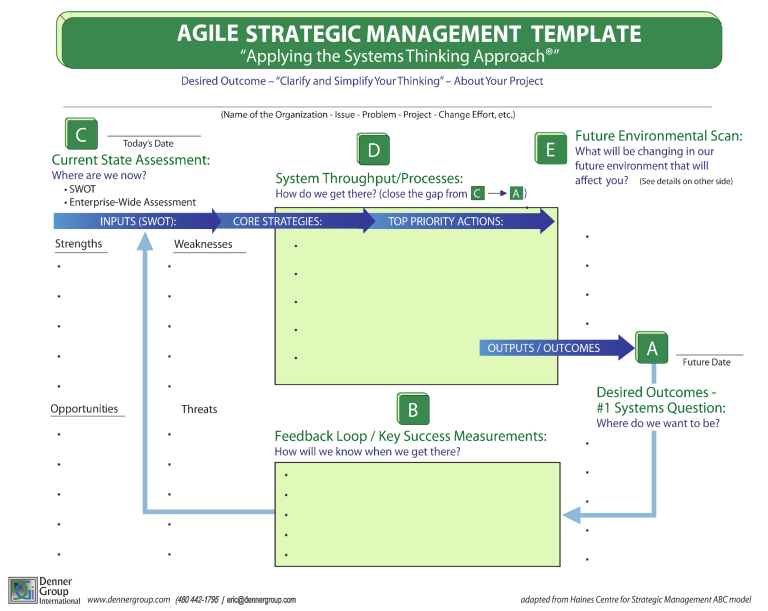Plan Strategies Should Include
Built-in course correction | Circular decision-making
Working their way around the template, a team can more quickly arrive at the strategies or specific initiatives and key actions they need to implement. The course corrections are motivated by the feedback loop, which is created at the beginning of the planning process, and updated regularly. Just as we use gauges in a car to monitor and adjust our speed, cabin temperature, fuel levels, and to continuously monitor the overall environment around our vehicle, the performance indicators in the feedback loop need to be adjusted from time to time. The tool helps to ensure we don’t overlook that part of decision-making and keeps it agile.
The circular process in the tool also reminds us that there is no beginning and end to decision-making; that the result of a decision really, and simply, leads to a “new normal” and new opportunities. The clarity that results from knowing and believing what becomes possible as a result of one or more decisions is energizing and focused, leading to progress and growth. Again, greater collaboration occurs through well-focused activities. The skills developed through repetitive use of the tool, help deliver quicker and better decisions.
SKEPTIC Tool
This tool offers the quickest way we have found to concentrate a group’s attention on the possible future outcomes of a project or initiative. These could be really long term, such as five to ten-year horizons for a strategic plan or construction project, or a shorter term of a few months for a marketing or software development project.
By focusing on FUTURE TRENDS, not past trends, for each element of the SKEPTIC MODEL, a group capturing the key elements of the discussions creates a valuable picture of the project’s or the organization’s future Opportunities and Threats. This means a 2-to-4-hour meeting can really bring the project or initiative into focus about how a vision or goal can be achieved in collaboration. Better still, the participants are already gaining buy-in and developing trust in one another.
The SKEPTIC MODEL can be used to guide a FUTURE TRENDS exercise for just about any initiative. Some elements can be ignored or added to bring agility into the mix. Applying the same framework time after time helps drive a disciplined process and produces quick results. It also fosters a focus on quick decision-making when making plans and more easily adapt to changes in the road map being laid out for the project or initiative. This dovetails nicely with the ABC Strategic Thinking planning model or Agile Decision Making Framework.
Rule of Three
The Rule of 3 applies to prioritizing tasks. This supports Sprint Decisions by keeping the number of tasks being concentrated on to no more than three.
It has been proven that people can only truly concentrate on three things at once. Any more than that leads us into the trap that “if everything on our list is a priority, then nothing is really a priority”.
If each of the three items we have selected are the most important, we keep them in a 1, 2, 3 order of priority.
Then we can achieve a Sprint Decision, and only move a new item onto that list once one of the three is complete.
We recommend making a list of tasks to accomplish and assigning them to 3-month, 6-month and we-month timeframes.
Focus on the tasks in the next three months first. As one task is completed, move the most important task from the 6-month timeframe up into the 3-month timeframe.
During the course of the year, all tasks will be addressed and/or others will be added as substitutes.
This makes the execution of a plan much more effective and easier to accomplish. The tasks are taken in bite-size pieces according to which three are the highest priority to address at any point in time.

Web of Relationships
Sprint Decisions are naturally subject to the Web of Relationships and the Law of Unintended Consequences.
In order to mitigate the Unintended Consequences, consider what happens when you turn one side of a new Rubik’s Cube. Initially each side is a solid color comprised of several squares. Once one side is turned, not only is that side affected, but so are three others. This was not the intention.
Translating this example to a management decision, by considering which other parts (sides) of the organization will be affected, you can make a Sprint Decision that avoids mostly or completely any unintended consequences.
Having clarity on that Web of Relationships supports the Agility that we are seeking in implementing the actions defined by our decisions. We can anticipate the course changes resulting from the expected, no longer unintended, consequences.
When embarking on a change project, it helps to include representatives from every department in the organization what might be affected by the change. It could be a new software installation or update. It may be a new form that is required to request support from another department. Simply launching the project without informing and inviting feedback from others, can lead to unintended consequences.
Root Causes
Sprint Decisions require simplicity. It is important to remove the complexity inherent in the issues and systems we are making decisions about.
A very useful tool to achieve this is to conduct a brief exercise exploring and defining the root causes of any problems we encounter.
Frequently, there are multiple causes with multiple effects. This exercise, using free-flowing and participative techniques, more quickly finds the linkages.
This avoids the propensity for quick fixes and simplistic “cause and effect” analyses which can create additional and unwanted problems.
By deeply exploring these root causes, we uncover the timing references between them that, when overlooked, can have enormous influence.
Sprint decisions by their nature imply the expectation of quick results, so we need to be aware of the long-lasting effects of those decisions.



©Copyright 2023. All rights reserved.
We need your consent to load the translations
We use a third-party service to translate the website content that may collect data about your activity. Please review the details and accept the service to view the translations.
